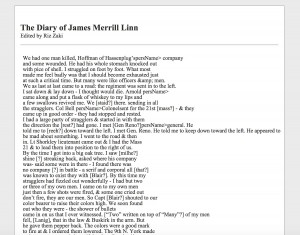The process of marking up text itself reveals some key inherent aspects. As I built my TEI file, I saw the structure of the text as dictated by the appearance of objects, places and their relationships and definitions. For example, I noticed the relatively few times places were mentioned in the text. Only one place, “the road” was mentioned within Linn’s narrative for my section of text, events were tied to names not places. After going through the process it is evident that the marked up file is inherently different than the original. One problem I encountered was determining the amount of information and detail to include in my markup. If I did too little I might end up losing important meaning or details, marking up too much risked obscuring the original text. Pierazzo comments on this dilemma and notes that a transition can be viewed as model of a physical object, considering there are an infinite number of details present in a physical object, one might be tempted to create a model that aspires to be the original as much as possible, however, a model is useless unless it is a simplification of what it models. Pierazzo suggests this balance between too much and too little detail can be remedied with a application of a “grid of features” , a hierarchy of what characteristics of a text are important.

The collaborative process changed the way I thought of edited work production. For the tagging of words, what might be an obvious tag for one might not be for another, while neither would have reasons completely disproving the other. Compromise was the eventual outcome thus collaborative texts are built on compromises between differing viewpoints. When considering other’s viewpoints on the same text, one gains the appreciation of how one’s own editing is the result of their own interpretation.
Elena Pierazzo mentions this as part of a larger phenomenon encountered in digital transcriptions, that is the essential effect of the transcriber when they chose what to bring to light. Pierazzo claims that a text in its original form contains an infinite number of facts and that transcription is “a substantially interpretive act” as only a finite number of those facts can be presented in a marked transcription.
For example, place vs. object was a significant issue that was brought up in class. Is the Cossack, a ship, a place or an object? Some considered the Cossack an object as all ships are objects, others considered it a place as it behaves this way in Linn’s narrative, much like a house. The finished collaborative transcription is very different from one made individually. Pierazzo mentions this distinction with her description of a diplomatic edition.
Pierazzo claims that a direct transcription is “a derivative document that holds a relationship with the transcribed document.” A diplomatic transcription however, is a “formal presentation of such a derivative document” that is proofread, corrected and peer reviewed before publication for the public.
